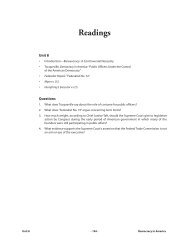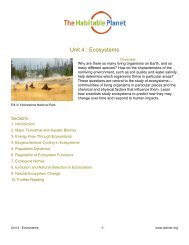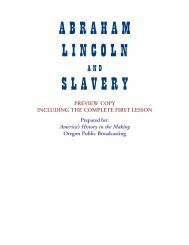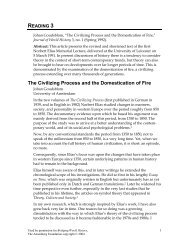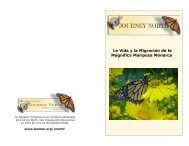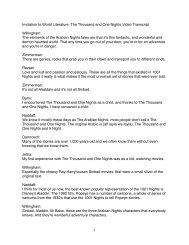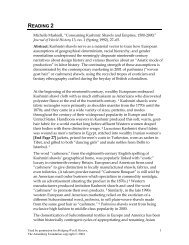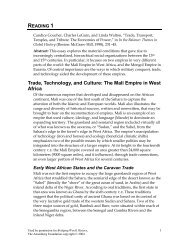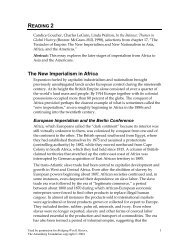UTOPIAN PROMISE - Annenberg Media
UTOPIAN PROMISE - Annenberg Media
UTOPIAN PROMISE - Annenberg Media
Create successful ePaper yourself
Turn your PDF publications into a flip-book with our unique Google optimized e-Paper software.
[4427] John Stevens, The Mary Carr<br />
Stone (1721), courtesy of Wesleyan<br />
University Press. The Mary Carr Stone, in<br />
Old Common Burying-ground in<br />
Newport, Rhode Island, reads “Here<br />
lyeth the Body of Mary the Wife of John<br />
Carr, Dyed Sepr; ye 28th: 1721: in ye<br />
21st: year of her age.” The carving was<br />
made by the elder Stevens, a carver<br />
known for both the quality and the innovativeness<br />
of his work. The stone’s<br />
imagery emphasizes rebirth. The sides<br />
and bottom feature intricate leaf patterns,<br />
pilasters, rosettes: flower and<br />
leaves were associated with the life of<br />
man (Job 14) and fecundity. At the top is<br />
a cherub with wings, and at the base is<br />
a pair of peacocks, symbols of immortality.<br />
[4433] Michael Wigglesworth, The Day<br />
of Doom. Or, A Short Description of the<br />
Great and Last Judgment. With a Short<br />
Discourse about Eternity. By Michael<br />
Wigglesworth. The Seventh Edition,<br />
Enlarged. With a recommendatory epistle<br />
(in verse) by the Rev. Mr. John Mitchel<br />
(1715), courtesy of the Tracy W.<br />
McGregor Library of American History,<br />
University of Virginia. Originally published<br />
in 1662, this New England bestseller<br />
was often memorized by the pious:<br />
by 1715 it was already in its seventh<br />
edition. The poem tells of the coming of<br />
Christ on judgment day and the separating<br />
of the sheep (saved) from the goats<br />
(unsaved). A jeremiad, the text uses fire<br />
and brimstone to encourage sinful readers<br />
to repent.<br />
36 UNIT 3, <strong>UTOPIAN</strong> <strong>PROMISE</strong><br />
Context: Compare Wigglesworth’s “Day of Doom” with Taylor’s<br />
“Meditation 42” and Bradstreet’s “The Flesh and the Spirit.”<br />
Compare the poets’ visions of the afterlife. Do they have different<br />
views about God’s wrathfulness? About his mercy? What do their<br />
descriptions of heaven have in common? How are they different?<br />
Context: Examine the engraved images on the gravestones featured in<br />
the archive; then skim the poetry of Anne Bradstreet and Edward<br />
Taylor. Do you find any overlap in the imagery deployed? When you<br />
find similar imagery used (birds or flowers, for example), examine<br />
the context carefully. Do you think the stone carvers invested these<br />
symbols with the same meaning that Bradstreet or Taylor did? Why<br />
or why not?<br />
Exploration: As you have read, apocalyptic thinking gained great cultural<br />
currency in New England in the seventeenth century. In our<br />
own time, anxiety about the Cold War and the dawning of the year<br />
2000 created a great deal of interest in the Apocalypse. How does<br />
late-twentieth-century thinking about the Apocalypse compare to<br />
Puritan apocalyptic ideas? How do contemporary films and literature<br />
having to do with the Apocalypse compare to Puritan writings?<br />
Exploration: Puritans often used Wigglesworth’s “Day of Doom” to<br />
teach children basic religious and social principles. What effect do<br />
you think the poem would have on young children? How does the<br />
poem compare to Victorian and twentieth-century poetry created<br />
for children? How do you think American attitudes toward childhood<br />
have changed since the seventeenth century?<br />
Exploration: Examine the Puritan gravestones in the archive; then<br />
think about other, later American graves you may have seen<br />
(Grant’s tomb, Kennedy’s eternal flame, battlefield grave markers,<br />
etc.). What kinds of cultural values and attitudes toward death<br />
do these later graves reflect? How are they different from Puritan<br />
values?<br />
Souls in Need of Salvation, Satan’s Agents, or Brothers in<br />
Peace?: English Settlers’ Views of Native Americans<br />
When English immigrants set sail for the “New World” in the early<br />
seventeenth century, many of them believed that they would be settling<br />
what William Bradford called “a vast and unpeopled country.”<br />
When they arrived in America, however, they found not an empty<br />
wilderness but a developed region with a large population of Native<br />
Americans. Despite tendencies to view “the Indians” as a monolithic<br />
group, it is important to realize that Native American culture was<br />
extremely diverse; different tribes spoke different languages, created<br />
different political structures, and developed distinct cultural practices.<br />
Often, they fought among themselves over rights to land and game.<br />
Native American communities developed different strategies for dealing<br />
with the European settlers who began descending on their land in<br />
the seventeenth century: some opted to resist, some fled their traditional<br />
homelands, some sought accommodation, and some struck



